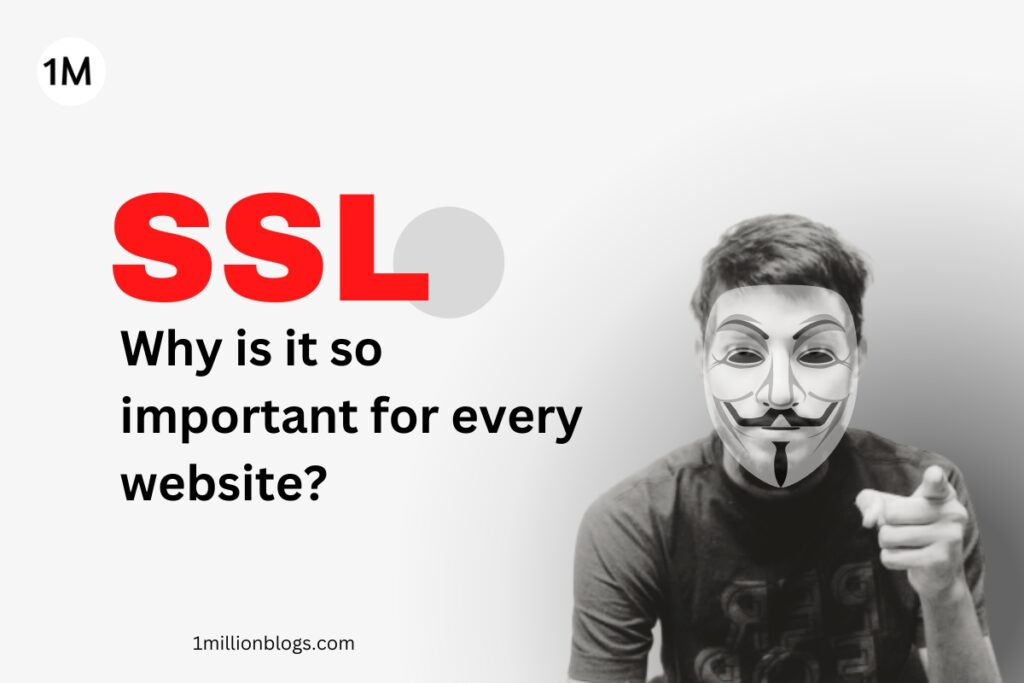Your consumers and website visitors expect your website, whether it’s a personal blog or an e-commerce platform, to offer a secure connection. If you want to display authentication, your website needs an SSL certificate.
While exploring multiple websites, you may have noticed them moving from old HTTP to the secure HTTPS version. With SSL, your website will show “Not secure” on browsers, as shown below.

Well, this blog will let you understand everything about SSL and how to get one for your website.
What is an SSL?
SSL stands for Secure Sockets Layer which secures data that is being transferred from your website to the visitors’ computers. It is a security protocol that provides an encryption layer between a web server and a web browser.
Companies need an SSL certificate to secure their customer’s details and transaction information. It keeps hackers away from reading or modifying this sensitive information for any illegal use.
What data does it secure?
When someone visits your website, all the information is transferred back and forth between their browser and your website. SSL provides a protective layer between these two just like you use tempered glass to protect your phone’s screen.
It protects data like:
- Name (login credentials)
- Postal addresses
- Legal contracts or documents
- Email-address
- Passwords
- Credit card numbers, etc.
If any website requires visitors to log in for membership or it’s an online store, it needs to be SSL protected. However, Google recommends all websites have an SSL certificate to protect their visitor’s data. It even improves search engine ranking so that you can have more visitors.
How does an SSL keep information secure?
An SSL provides a certificate that contains a piece of code to enable encryption digitally. It works just like a lock-key system. You use them to protect your house and belongings, SSL protects information and with the right key only, you can access the information.
Each SSL consists of two keys that have separate functions:
- Public key: encrypt the information by using an encryption algorithm.
- Privacy key: decrypt the information and restore it in its original format.
It works in the following ways
- A browser tries to connect to a website that is secured with SSL.
- The browser requests the web server to identify itself first.
- The web server sends the browser a copy of its SSL certificate.
- The browser verifies whether it trusts the SSL certificate or not.
- The web server then returns a digitally signed acknowledgment to start an SSL-encrypted session.
- Encrypted data is then shared between these two.
This process is referred to as an “SSL Handshake” and it takes place in milliseconds.
Why is it important for bloggers?
SSL keeps your data secure, verifies ownership, protects hackers from creating a fake version of your website, and displays integrity and trust to your visitors.
However, it’s also crucial for bloggers to have an SSL certificate for their websites.
It has the following advantages:
- You can protect your visitor’s sensitive information.
- It helps in detecting any kinds of threats coming from hackers.
- Google rewards HTTPS websites by improving their ranking in the search engine.
- Your visitors will increase and you may get new leads easily.
- SSL makes your website look more professional and trustworthy.
- It will help in boosting your SEO strategies and techniques for your blogs.
- It will help in expanding and monetizing your website.
- You will get a competitive advantage in your niche.
Therefore, SSL is important for your blogging website to establish yourself in this domain.
How to check if any site has an SSL certificate?
It’s easy to check if any website has SSL or not. When any website is SSL protected, HTTPS (Hyper-Text Transfer Protocol Secure) appears in the URL, but if not then it appears without the “S- Secure” in the URL. Sometimes, your browser will also show if your connection is not secure with a warning.
You can also see the padlock icon next to the URL in the address bar to check whether the website is SSL protected or not.

You can click on the padlock icon to view the SSL certificate details. It has information on the domain on which the certificate is issued, its issue and expiration date, and which certificate authority has issued it with its signature.
How to get an SSL certificate for your blog?
You can get an SSL certificate from “Certificate Authorities”. Various domain registrars offer these certificates whose cost range between $35- $270 per year.
However, for many blogging websites, you don’t need to pay this much amount. You can get SSL for free as some leading WordPress hosting companies provide SSL certificates with hosting plans.
Such as “Bluehost Hosting” offers a free domain, great customer support, and SSL with reasonable prices, especially for bloggers. Your free SSL certificate will be activated once you signup with Bluehost. For existing users, you will find it by clicking on “My sites”, and moving along to the security tab.
How to install an SSL certificate in WordPress?
After switching to a free SSL certificate, you have to set up WordPress to start using HTTPS in all your URLs. You can install and activate Really Simple SSL plugin for this purpose.
After installation, it will run some initial checks and configuration in the background and once it’s done you will notice successful green check marks.







Well explained. Even a novice like me could understand it.
Thank you. I am glad you found this post helpful. Don’t forget to read more of our blogs.
Sometimes we ignore such minor details in order to prevent extra expenses while maintaining our website but it’s really important to notice them and put in extra efforts.
This blog explained such a complicated subject in such an easy way (as I’m never into technology).